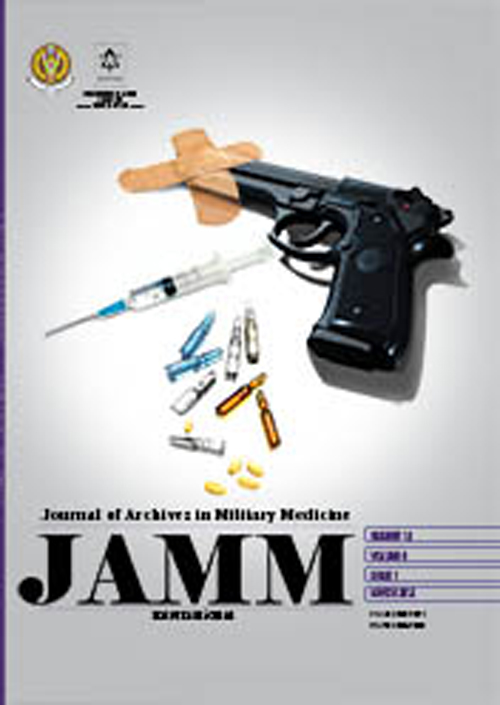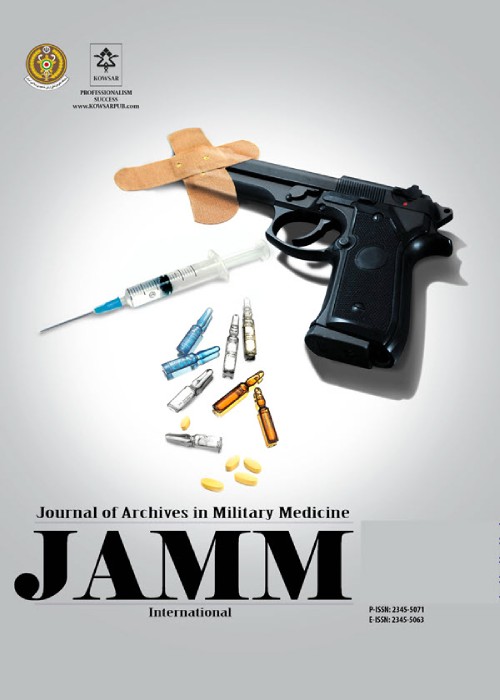فهرست مطالب

Journal of Archives in Military Medicine
Volume:6 Issue: 3, Sep 2018
- تاریخ انتشار: 1397/06/10
- تعداد عناوین: 2
-
-
Page 1BackgroundPhysical readiness plays an important role in a navy student’s life.ObjectivesThe current study aimed at building a valid and accurate statistical model using the physical readiness variables to predict the best military category for the students of the NEDAJA and putting the complex concepts of this model to a practical tool such as nomogram.MethodsThe current cross sectional study included all the navy students (Islamic Republic of Iran Navy) studying from 2011 to 2012 in the Imam Khomeini Naval University of Noshahr. Out of 733 students in the university, 260 were randomly selected and measured in terms of physical readiness variables. The number of subjects in each group was calculated using binary logistic regression. The Stata/MP ‘nomolog’ command was used to develop nomogram after building the finalized model by logit prediction command (binary logistic regression model).ResultsThe mean age of the subjects was 21.2 ± 2.1 years; 59 out of 171 participants (34.5%) in navigation, 78 (45.6%) in marine, 26 (15.2%) in sea scouts, 50 (29.2%) in electronics, and 59 (34.5%) in mechanics categories met the inclusion criteria. The nomogram was developed according to the inclusion criteria for each model. After matching the values of independent variables by the appropriate score, the probability, which responds to the total points, is figured out. The benefit of a nomogram maps the measure of associations into easy scores on a scale from 0 to 100 in a user-friendly figure. The total points collected by the various independent variables correspond to the predicted probability for a student.ConclusionsA nomogram was developed to predict the best military category for the Iranian navy students, using the variables from the physical readiness. It showed excellent discriminating and predicting ability with high accuracy. To the authors’ best knowledge it was the first paper that developed nomogram to be used in military medicine.Keywords: Nomogram, Logistic Regression, Physical Fitness
-
Page 2BackgroundMonoclonal antibodies are increasingly being employed in oncology, toxicology, infectious diseases and rheumatology owing to unmatched efficacy and safety; nevertheless, their usage in developing countries is restricted due to high cost to the exchequer. The newer production line of monoclonal antibodies comes forth with improved efficacy and safety of the current generation monoclonal antibodies and has led to a meteoric growth in their utility.MethodsWe performed a comparative analysis of consumption pattern of monoclonal antibodies in a sponsored tertiary-care healthcare system during 2013 - 2017. The humanized anti-IgE monoclonal antibody, omalizumab, was compared with various groups of drugs used for the treatment of bronchial asthma such as combination of long-acting β-agonists and inhaled corticosteroids, short-acting β-agonists and anticholinergics, and inhaled corticosteroids and leukotriene receptor antagonists.ResultsThe consumption pattern revealed a three-fold increase in the number of monoclonal antibodies during 2016 - 2017 compared to the three-year period from 2013 to 2015. Omalizumab incurred the highest cost burden relative to other medicines used in bronchial asthma. The comparative analysis of usage pattern of monoclonal antibodies, immunomodulators, anti-HIV drugs and all insulin preparations demonstrates annually rising cost burden of monoclonal antibodies.ConclusionsThe study showed an increasing trend of healthcare costs and proportionately increasing use of monoclonal antibodies, which add to the quality of care through increased efficacy and safety. We need to accept the fact that quality comes with an additional cost burden, and costs can be optimized with economy of scale.Keywords: Monoclonal Antibodies, Immunotherapy, Omalizumab, Efficacy, Drug Safety


